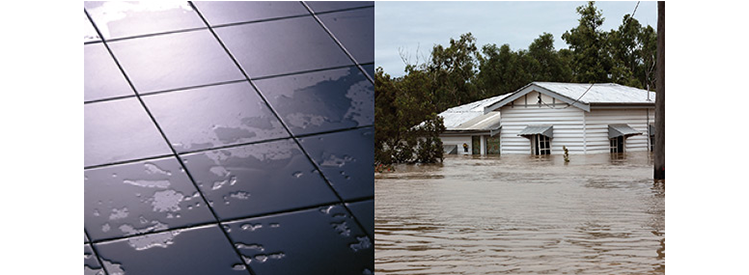
The first thing that needs to be recognised is that flood water will not normally 'damage' vitrified, ceramic, or glass tiles. Marking of these tiles is typically surface dirt which can be removed by washing but where the surface is highly porous, staining materials can penetrate and may not be removable. The same applies to stone tiles, and the porous rock types are much more likely to suffer permanent marking and discolouration. Cement based grouts are likewise not necessarily affected by the water, but can also suffer staining that cannot be removed.
'Moisture unstable tiles' - those that warp or change dimension - can create problems when flooded because any expansion or warping (usually from the top down) can crack the grout and damage the adhesive bed. Where there is evidence of tile movement or warping it is almost inevitable that the tiles will need to be replaced.
Cleaning processes need to be thorough but sympathetic to the types of tiles being cleaned, and the use of mineral acids needs to be very carefully examined, particularly with regards to damaging grouts.
Where the tiles cannot be cleaned or have suffered physical damage there is no choice but to replace them.
Each installation will have to be assessed separately, and particular attention should be paid to tile beds over surfaces damaged by water (plasterboard and timber), but also where there is public risk (such as external and internal facades or fascias) or large and heavy format tiles that have been bonded on vertical surfaces. Where water comes out of a tile bed that is walked on, it is a good bet that the system has been damaged and needs to be replaced. Below grade tiled areas are much more likely to require replacement because of longer inundation, but also due to longer ongoing dampness.
Treat with a moisture barrier system such as a water based epoxy to suppress rising damp and also to some extent obnoxious odours. This can allow earlier rectification and reinstatement of the tiled areas, but at the same time it needs to be recognised that these wet substrates are going to be subject to movements till the dampness dissipates. Sand-cement screed beds can be treated in the same way, but tend to be contaminated sufficiently that they would be better replaced
Yes, this is very important and concrete or block work must be mechanically prepared which will also remove contaminants from the immediate concrete surface. Render may be able to be prepared in the same way, but it is more likely to suffer mechanical damage and require removal and replacement.
We do not recommend taking short-cuts such as severe sanding back of timber floors for direct installation or re-sheeting and tiling.
Where there is risk of further flooding, the use of adhesives suitable for full immersion such as those used in swimming pools may make a tiled installation on masonry surfaces more resistant to damage, though only correct detailing and avoidance of adhesive voids will reduce problems with debris trapped in the bed.